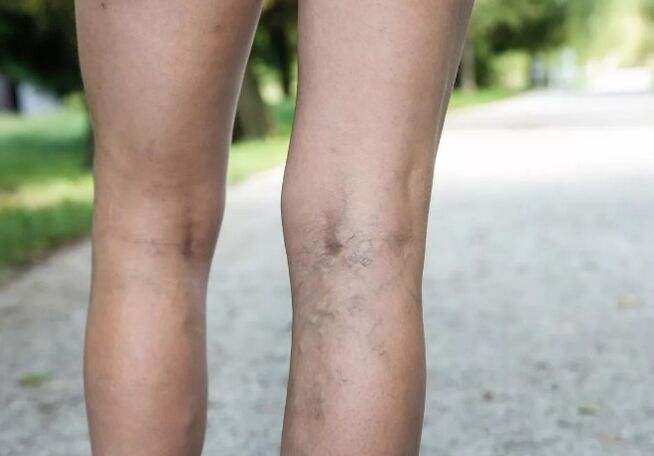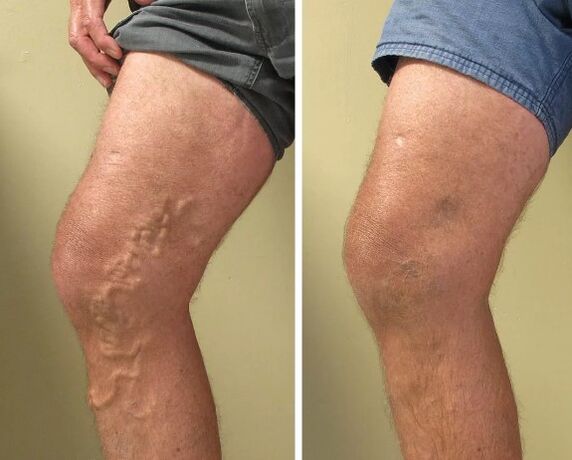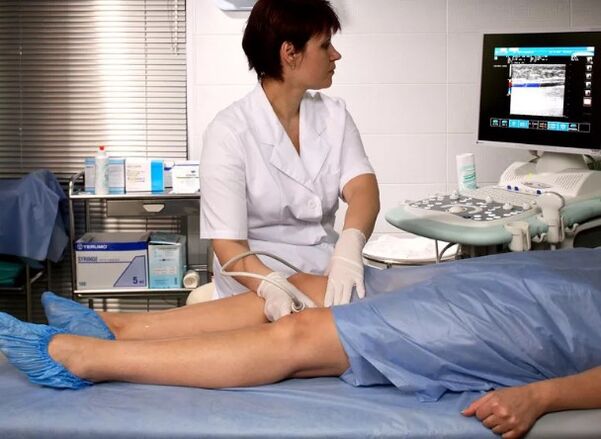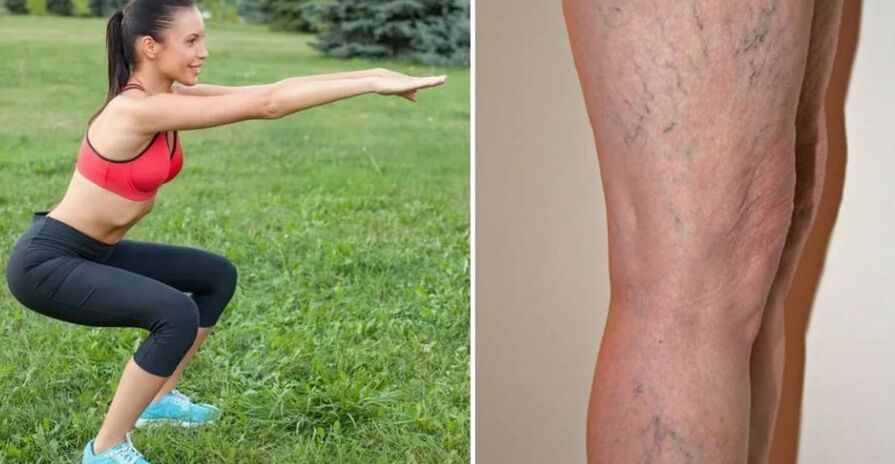The varicose veins on the legs are a specific expansion of the veins of the lower ends, which is accompanied by a general violation of the blood flow and the failure of the valve. The expansion of the veins is characteristic of women and men aged between 40 and 60 years old.

Development mechanism
The trigger in the development of a pathology such as varicose veins is considered a violation of the normal functioning of the venous valves with the occurrence of blood reflux (reflux - reverse current). On a cellular level, this is associated with a violation of the balance between some components of the venous wall.
The initial phase is characterized by the presence of a genetic and causal factor (prolonged living room in sitting position, excess weight, injuries and so on). At the same time, the so -called cutting stress parameter, which is a set of blood movement indicators through the vases, to which the endothelium reacts in a very sensitive way.
If the irritating factor acts for a long time on the ship's wall, leukocytes are firmly fixed to endothelial cells, which cause the initial stage of inflammation. The inflammatory process spreads through the venous channel of the lower ends.
Especially quickly, these processes occur in the valves, which are subject to constant and heavy mechanical stresses. However, inflammation on one leg can be more pronounced than the other. First of all, it depends on the initial cause of the damage to the organ, for example, on the right leg, the varicose veins can be more pronounced among the athletes that are emphasis.
With damage to the valves, a pathological discharge of blood occurs through the mouth of a large and small subcutaneous vein. Due to the restart, an excess flow of blood occurs, the wall of the venous vessels occurs.
Over time, dynamic venous hypertension is developed, which is characterized by a decrease in pressure in the pot, as a rule, this occurs during the walk, in terms of impossibility of guaranteeing the normal perfusion of the blood through the tissue.
This process is accompanied by Edema, impregnation of subcutaneous tissue with blood cells (red blood cells and leukocytes). Over time, the skin changes color, swelling, skin pigmentation has improved. With the death of the cells, which is not indecent during medical treatment, which further leads to the development of trophic ulcers.

Classification of varicose veins
A new classification of the varicose veins of the lower ends has been developed since 2000.
Forms of varicose veins:
- Intradermal or segmental varicose veins without pathological changes;
- Segmental varicose veins with superficial veno reflux;
- Common varicose veins of the surface veins;
- Varicose expansion in the presence of reflux of deep veins.
The degree of chronic venous insufficiency:
- 0 - It does not develop;
- I - "heavy legs" syndrome, the appearance of the Edema;
- II - persistent edema, eczema, lipodermosclerosis;
- III - Trophical ulcer.
The complications of the venous expansion of the veins of the lower limb are one of the serious conditions that affect the body: thrombophlebitis, trophic ulcers, erisipela, erisipela or bleeding.
Work classification of the disease
By shape:
- Varicose veins of the subcutaneous vein of the thigh (starting from the mouth) - descendants varicose veins;
- Ascending varicose veins (defeat of wen, lower legs and feet, starting from the bottom up);
From clinical groups:
- The first group is an internal segmental expansion of veins without perforator;
- The second group is the expansion of fragments of venous trunks;
- The third group is the expansion of the subcutaneous vein of the thigh and the lower part of the leg;
- The fourth group is a varicose extension of a large and small subcutaneous vein with the presence of insolvent perforators;
- The fifth group is the expansion of the surface veins, a large and small subcutaneous vein with tissue induction.
The classification of work for complications and the degree of chronic insufficiency does not differ from the standard.
The reasons for the development of varicose veins
The exact reason for the development of this pathology has not yet been completely clarified, but there are a series of factors that contribute to the occurrence of varicose veins:
- Genetic predisposition (the mutant gene responsible for the structure of the wall of the pot is transmitted);
- Changes in the hormonal background (pregnancy - during pregnancy, the composition of hormones in the body changes (the amount of progesterone increases and decreases estrogen), which directly influences the formation of blood coagulation factors);
- obesity (overweight leads to a sedentary lifestyle and, consequently, to a break);
- Diabetes mellitus (increased blood sugar over time damaging the vessel wall over time);
- alcohol abuse (a large amount of alcohol in the blood is the cause of dehydration and blood condensation);
- heavy physical activity;
- congenital blood coagulation disorders;
- irrational nutrition, errors in the diet;
- Uncomfortable and neighboring panties (wearing constant leads to a compression of the blood vessels);
- frequent constipation (increase in intra -abdominal pressure leads to a difficult flow of blood in the lower limbs);
- constant walking in heels (stagnation development and insufficient muscle movement);
- increase in air temperature (leads to dehydration, blood condensation and, consequently, to the formation of blood clots);
- diseases of the cardiovascular system and kidneys;
- overdose of drugs that increase blood coagulation;
- Surgery (blood loss, compression of the vases).

Phase of varicose veins
For this period of development of medicine, three main phases of the development of varicose veins and the initial phase are distinguished, when the disease is very difficult to notice.
The initial phase of the disease is accompanied by swelling, weight, very often sick, it complains that the legs hurt during a long walk. These are all signs of the start of the pathology, it is time to start prevention: massage, legs for legs, physical activity.
The expansion of the veins of the 1st degree.This phase is characterized by all the symptoms listed above, to which are added vascular stars, bruises on the legs, knotted veins, visible through the skin. In addition, the aspect of convulsions at night and combustion in the stop area is noted.
The expansion of the 2nd degree veins.At this stage, the total number of stars and knots increases, become more evident. It appears swelling, the pain in the legs increases and becomes unbearable to endure it.
The expansion of the veins of the 3rd degree. This is the most difficult of the stage, which is accompanied by serious lesions of the skin of the legs, becomes dry, lifeless and broken. The skin of the lower leg becomes dark blue, its structure and pigmentation are changing.
The third phase is the last when this pathological process can be called varicose veins. The subsequent development of the processes ceases to more serious diseases.
It is advisable to consult a doctor in the second phase of the development of the disease, since over time medical treatments are not made in serious consequences.
The question immediately arises: "In which doctor will it go? ", The answer is simply: a doctor specialized in the pathology of the veins of the lower limbs is called a phlebologist.

Clinical varicose symptoms and veins
The main signs of this disease are numerous extensions of subcutaneous veins, which is why the disease is called. The beginning of the disease is generally accompanied by some non -specific characteristics.
In this state, patients feel gravity in the legs, rapid fatigue during movement, sometimes burning and cramps. In addition to the pain, the disease manifests itself from the edema that develops in the late afternoon, after a hard day of work.
With a varicose vein of long handle, symptoms such as eczema and itching appear. Patients scratch their legs, creating uncomfortable sensations. Due to the development of the disease, the skin above the veins becomes more subtle, the itchy places are constantly combed, which leads to the appearance of the wounds.
Over time, the color of the skin in the lower part of the leg becomes bluish. If medical assistance is not provided in this situation, the development of skin hyperpigmentation and lipodermasclerosis is possible. In even more advanced phases, trophic ulcers develop.
Diagnosis of the disease
The veins expanded in a varied way are visible and not armed with an armed appearance, however, how dangerous this condition must be discovered using instrumental diagnostic methods.
Currently, the most informative method is the ultrasound methodology of the Duplex scan of the veins. With his help, he is assessed by the functioning of the valves, by the ability of the transversal country and by the presence of blood clots. The timely study of the veins will avoid serious and irreversible consequences.
Treatment methods
How to treat varicose veins? Care completely the varicose veins is possible only with the help of the surgical intervention. People who have a hereditary predisposition or risk factors recommend visiting a specialist doctor 2-3 times a year, for the ultrasound examination of the veins, the operation with varicose veins is prescribed in the second phase of the development of the disease.
How much does the operation cost? The price can be committed differently, it all depends on the severity of the development of the disease.

Surgical treatment
Flobectomy
Indications for the removal of the veins: large varicose veins, pathological expansion of subcutaneous veins, trophic ulcers, acute thrombophlebitis, expansion of deep veins accompanied by general malaise (fatigue, dizziness).
Contraindications for the disease: coronary heart disease, pregnancy, elderly age, serious infectious diseases, inflammatory processes.
The advantage of surgical treatment is that this is the only effective method of treatment in advanced forms of the disease.
The disadvantage of this treatment: trauma, anesthesia, a long postoperative period.
Laser therapy (EVVK)
Indications: varicose veins on the legs in combination with various serious diseases (ischemia, thrombophlebitis, asthma, bronchitis, pleuralisy, ulcer, cholecystitis, pyelonefritite, peritonitis, dermatitis and bubbles).
Laser treatment is contraindicated in cases where it is noticed: oncology, liver diseases, kidneys, heart (decommin stadium), pregnancy and cerebral sclerosis.
The advantages of this treatment are to eliminate the vascular model, the maximum fast, painless and safe procedure, does not require stationary and atraumatic observation.
Disadvantages: it is not at all available, expensive, the appearance of scars or clarifications of the surrounding fabric is possible.
Radio -frequency coagulation of varicose veins
Indications: varicose veins with trunk damage of a small and large subcutaneous vein, trophic ulcers.
Contraindications: acute form of thrombophlebitis, mental disorders, pregnancy.
Advantages: Innightity, hospitalization is not requested after surgery, does not interfere with work.
Disadvantages: expensive procedure.
Sclerotherapy
Indications: varicose veins in the early stages.
Contraindications: pregnancy, breastfeeding, allergic reaction to sclerosing processes, purulent inflammatory legs, thrombosis.
The advantages of this method of treatment are that this financially treatment is cheaper than surgery, rapid recovery, the best cosmetic effect.
Disadvantages: perhaps, entering the deep veins of the sclerling, is not effective quite effective with the advanced shapes of the disease.
Pharmacological treatment
Pharmacological treatment helps to improve blood vessels, the state of the valves, improves the flow of blood and lymph and also eliminates inflammation, but does not heal the patient.
How to treat?

All the products needed by varicose veins are divided into:
- Flebotonic;
- Non -pound analgesics;
- hormonal drugs;
- antitromboid;
- Drugs based on aspirin.
Domestic treatment
Traditional medicine involves the use of various ointments, lotions, dyes, feet or decoctions.
Varicose vein apple vinegar treatment. It is impossible to treat such a disease with popular recipes, however, to relieve fairly real symptoms, especially in the initial phase of development. For this, apple cider vinegar is used for windings, cleaning, oral administration or compresses.
How to avoid the disease?
A sedentary lifestyle, standing work, pregnancy is a greater load, following which a disease like varicose veins develops.
Varicosis in women is the same problem as cellulite, therefore special creams, lotions, compression socks and lymphatic drainage have been developed to fight it.
According to statistics, varicose veins in men are extremely rare and even if it develops much more slowly.
Can I play sports?
Varicosis and running are two factors that always walk nearby. The most effective prevention of the expansion of the veins of any of the phases is constant physical effort: race, gymnastics, various force exercises on the legs, by bicycle and so on.
There are numerous simple exercises to improve blood flow and prevent varicose veins:
- The rotation of the foot clockwise 20 times in each direction.
- Work with your fingers. Extending and putting your fingers 20 times.
- Star with socks, then on the heels, and after having rolled from the heels to socks and back 20-30 times.
























